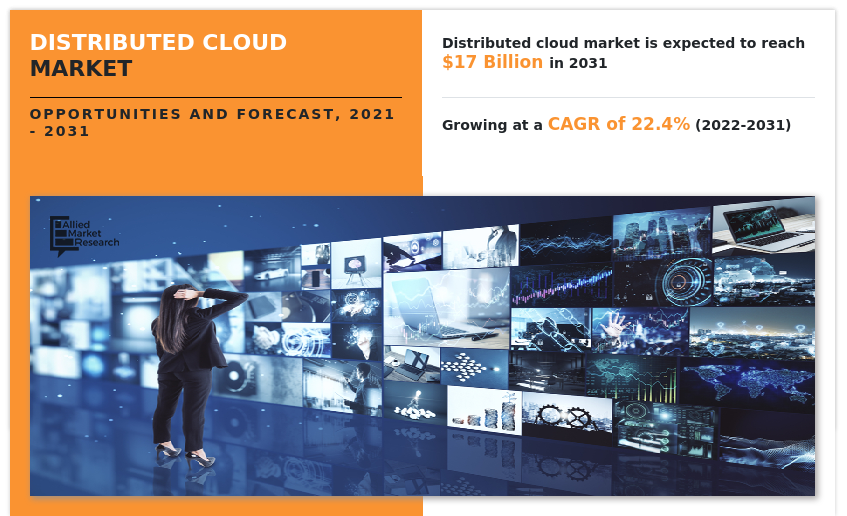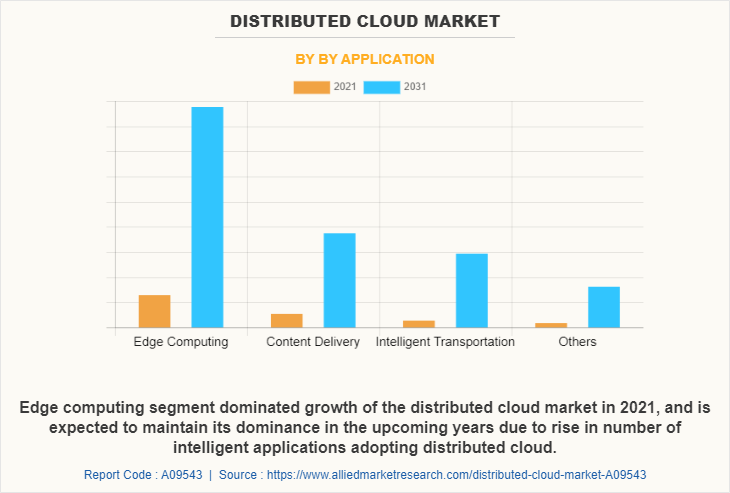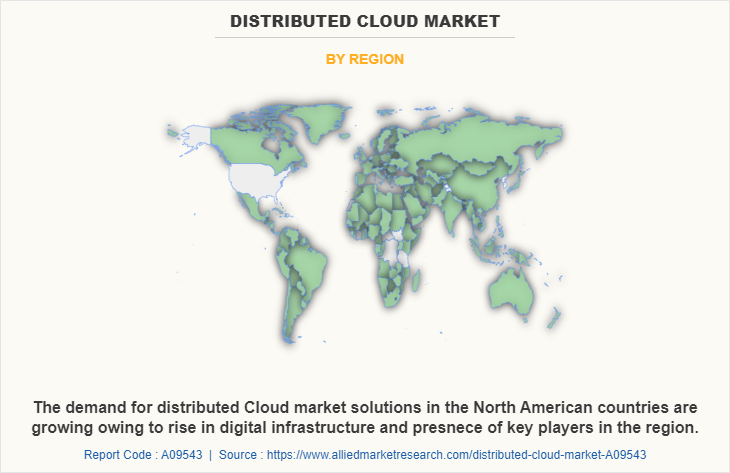Distributed Cloud Market Insights, 2031
The global distributed cloud market size was valued at USD 2.3 billion in 2021, and is projected to reach USD 17 billion by 2031, growing at a CAGR of 22.4% from 2022 to 2031.
Increase in use of mobile technology, rise in requirements for minimum data recovery, surge in use of digitization, higher workload and data processing, and better data recovery are the major drivers for the growth of the market. In addition, the ability of public cloud services to transition to better distributed cloud computing with high security drives the distributed cloud market growth. However, security concerns may hinder market expansion. In addition, adoption of cloud technology, launch of new products, and increase in government involvement in the implementation and promotion of cloud technology are expected to boost the distributed cloud market growth.

Distributed cloud is a cloud model that interconnects data and applications stored and managed on multiple locations into a centralized cloud platform. A distributed cloud is a cloud where processing, storage, and networking are in micro clouds, separate from the centralized cloud. In distributed cloud system, the distributed cloud is closer to the end user. Organizations can reduce latency, network congestion and the risk of data loss using a distributed cloud approach.
On the basis of type, the market is segmented into software public-resource computing and volunteer cloud computing. According to organization size, it is fragmented into large enterprises and SMEs. Depending on application, the market is segregated into edge computing, content delivery, intelligent transportation, and others. By industry vertical, the market is segmented into BFSI, healthcare, retail & E-commerce, manufacturing, IT & telecom, energy & utilities, media & entertainment, government & defense and others. Region wise, it is analyzed across North America, Europe, Asia-Pacific, and LAMEA.
Some of the major players in the distributed cloud market are Alibaba Cloud, Amazon Web Services Inc., Axway, CloudSigma AG, Databricks, DigitalOcean, LLC, Google, IBM, Liquid Web, LLC, MassiveGRID Inc., Microsoft Corporation, Oracle Corporation, Rackspace Technology, Salesforces Inc., SAP SE, Verizon, and VMware Inc. These players have adopted various strategies to increase their market penetration and strengthen their position in the industry.

By application, edge computing segment dominated growth of the distributed cloud market share in 2021, and is expected to maintain its dominance in the upcoming years due to rise in number of intelligent applications adopting distributed cloud. However, the intelligent transportation segment is expected to grow at the highest CAGR during the forecast period due to adoption of distributed cloud for faster data insights and integration of automation technologies to improve customer experience.

North America dominates the distributed cloud industry. Growth of the market in this region is attributed to several factors such as increase in digitalization and adoption of distributed cloud solutions by various sectors such as manufacturing, BFSI, and governments. Moreover, presence of key players provides ample growth opportunities for market growth. However, Asia-Pacific is expected to witness highest growth rate during the forecast period due to adoption of distributed cloud by number of SMEs in the region for cost-effectiveness and expansion of digital infrastructure in developing countries such as India and Singapore in the region.
Top Impacting Factors
Growth in the internet of things (IoT)
Increase in reach and adoption of IoT is anticipated to boost the growth of the distributed cloud market. In addition, it is a system of interrelated and interconnected computing devices, digital and mechanical machines, objects, and people that have unique identifiers while also having the capability to share data or information over a network without any interaction between human-to-human or human-to-computer.
For instance, in October 2021, Google launched a new suite of Edge and on-premise cloud products to rival the likes of AWS Outpost solutions, known as Google Distributed Cloud, consisting of hardware and software designed to extend Google’s infrastructure both to the Edge and into on-premise data centers. Furthermore, IoT has been rated as the main reason behind the fourth industrial revolution. The higher rate of acceptance of this cutting-edge technology is expected to aid the growth of the global market.
Increase in use of digital transformation technology
Digitization is the process of converting data or information into a digital format with the adoption of advance technology. It plays very important role in the business sector owing to surge in need among the companies for providing enhanced customer services and to improve the security of the customer. Furthermore, SaaS also helps companies to offer digital service to their customers and saves time on the business operation, which propels the growth of the market.
In addition, rise in demand for digital transformation technology in the organizations and rise in dependency of various companies on SaaS solutions drives the growth of the market. In addition, market players across the globe are adopting various advance technologies such as blockchain technology, big data and artificial intelligence to increase the productivity with minimal resource utilized. All these factors drive the growth of the distributed cloud.
COVID-19 Impact Analysis
The COVID-19 outbreak has considerably boosted growth of the distributed cloud services market due to accelerating demand for the cloud to support several crucial digital solutions in verticals such as BFSI and manufacturing and remote work, as well as entertainment platforms such as video streaming. Moreover, IT leaders of multiple organizations think it is very important to have a consistent operational experience between the edge and public and private clouds. But the data shows there are tremendous obstacles preventing that, mostly around establishing secure and reliable connections between providers, trying to navigate different support and consulting processes, and having to work with various platform services and this issue can be addressed with the help of distributed cloud systems. Hence, the COVID-19 have surely created huge opportunities for the distributed cloud system market.
Key Benefits For Stakeholders
- This report provides a quantitative analysis of the Distributed Cloud Market Forecast, current trends, estimations, and dynamics of the distributed cloud market analysis from 2021 to 2031 to identify the prevailing distributed cloud market opportunities.
- The market research is offered along with information related to key drivers, restraints, and opportunities.
- Porter's five forces analysis highlights the potency of buyers and suppliers to enable stakeholders make profit-oriented business decisions and strengthen their supplier-buyer network.
- In-depth analysis of the distributed cloud market segmentation assists to determine the prevailing market opportunities.
- Major countries in each region are mapped according to their revenue contribution to the global distributed cloud.
- Market player positioning facilitates benchmarking and provides a clear understanding of the present position of the market players.
- The report includes the analysis of the regional as well as global distributed cloud market trends, key players, market segments, application areas, and market growth strategies.
Distributed Cloud Market Report Highlights
| Aspects | Details |
| By Type |
|
| By Application |
|
| By Enterprise Size |
|
| By Industry Vertical |
|
| By Region |
|
| Key Market Players | Microsoft Corporation, Verizon, DigitalOcean, LLC, MassiveGRID Inc., Liquid Web, LLC, Alphabet (Google Inc.), Rackspace Technology, Alibaba Cloud, VMware Inc., Axway, Salesforces Inc., Databricks, CloudSigma AG, Oracle Corporation, .IBM CORPORATION, Amazon Web Services Inc., SAP SE |
Analyst Review
In accordance with insights by CXOs of leading companies, the global distributed cloud market is projected to witness prominent growth, especially in Asia-Pacific and North America. This growth is attributed to increased investments by organizations for automation and adoption of distributed cloud by verticals such as BFSI, manufacturing. In addition, adoption of IoT and AI in distributed cloud provides ample growth opportunities for the distributed cloud market. Furthermore, major cloud providers around the globe experienced year-over-year revenue growth due to COVID-19 pandemic during 2020. The pandemic-driven restrictions accelerated demand for the cloud services to support crucial digital solutions such as remote work and e-commerce, as well as entertainment platforms such as online gaming and video streaming.
The CXOs further added that the distributed cloud services market is competitive and comprises number of regional and global vendors competing based on factors such as cost of solution and services, reliability, and support services. The growth of the market is impacted by rapid advances in the cloud service offerings, and adoption of distributed cloud by various vendors is impacted by COVID-19 conditions and industry development.
Moreover, enterprises make significant investments in mergers and acquisitions to enhance their existing solutions and deliver new solutions for distributed technology. For instance, in July 2021, DigitalOcean Inc. has acquired Nimbella. Nimbella is a serverless platform provider. This acquisition will enable DigitalOcean to expand its capabilities in the Function-as-a-Service market. DigitalOcean will also add Nimbella's serverless compute offerings to its portfolio of Infrastructure-as-a-Service and Platform-as-a-Service offerings.
Prominent market players are exploring new technologies and platforms to meet increase in customer demands. Product launches, partnerships, and acquisitions are expected to enable them to expand their product portfolios and penetrate different regions. For instance, in June 2022, Google has launched a new private networking solutions portfolio. This will enhance the adoption of private cellular networks. These solutions are supported by Google Distributed Cloud Edge and Google's ISV ecosystem. Google cloud will handle different performance needs, service-level needs, and economic needs of the industry.
The global distributed cloud market was valued at $2,274.43 million in 2021, and is projected to reach $17,041.18 million by 2031.
The distributed cloud market is projected to grow at a compound annual growth rate of 22.4% from 2022 to 2031.
Some of the major players in the market are Alibaba Cloud, Amazon Web Services Inc., Axway, CloudSigma AG, Databricks, DigitalOcean, LLC, Google, IBM, Liquid Web, LLC, MassiveGRID Inc., Microsoft Corporation, Oracle Corporation, Rackspace Technology, Salesforces Inc., SAP SE, Verizon, and VMware Inc. These players have adopted various strategies to increase their market penetration and strengthen their position in the industry.
North America dominates the distributed cloud industry.
Increase in use of mobile technology, rise in requirements for minimum data recovery, surge in use of digitization, higher workload and data processing, and better data recovery are the major drivers for the growth of the market. In addition, the ability of public cloud services to transition to better distributed cloud computing with high security drives the market growth.
Loading Table Of Content...



